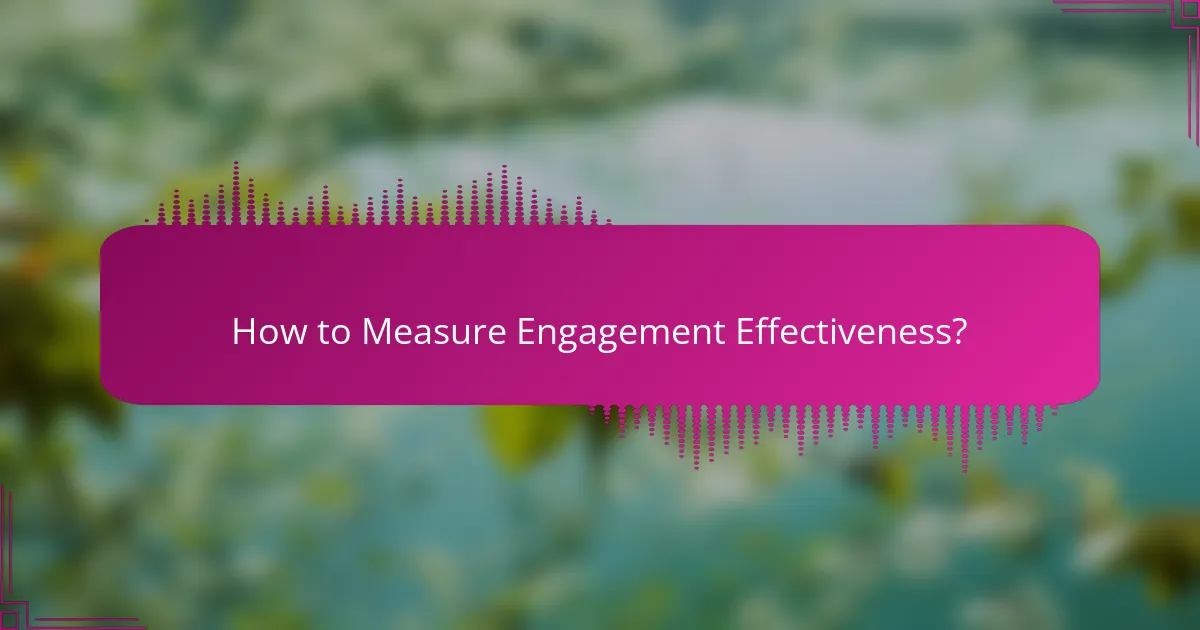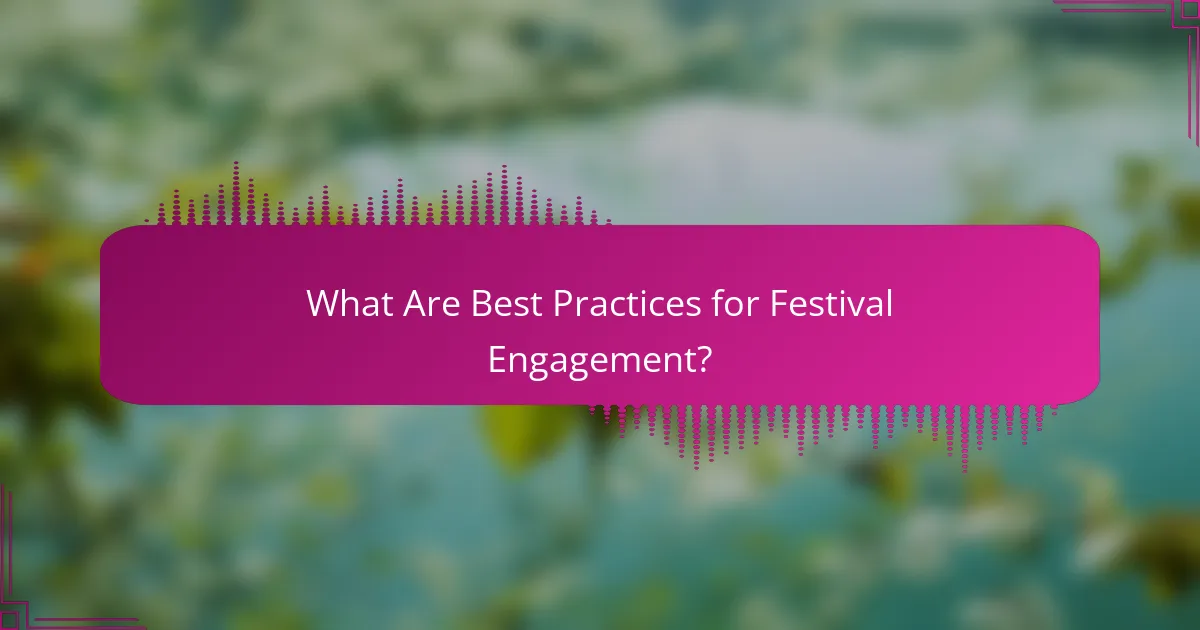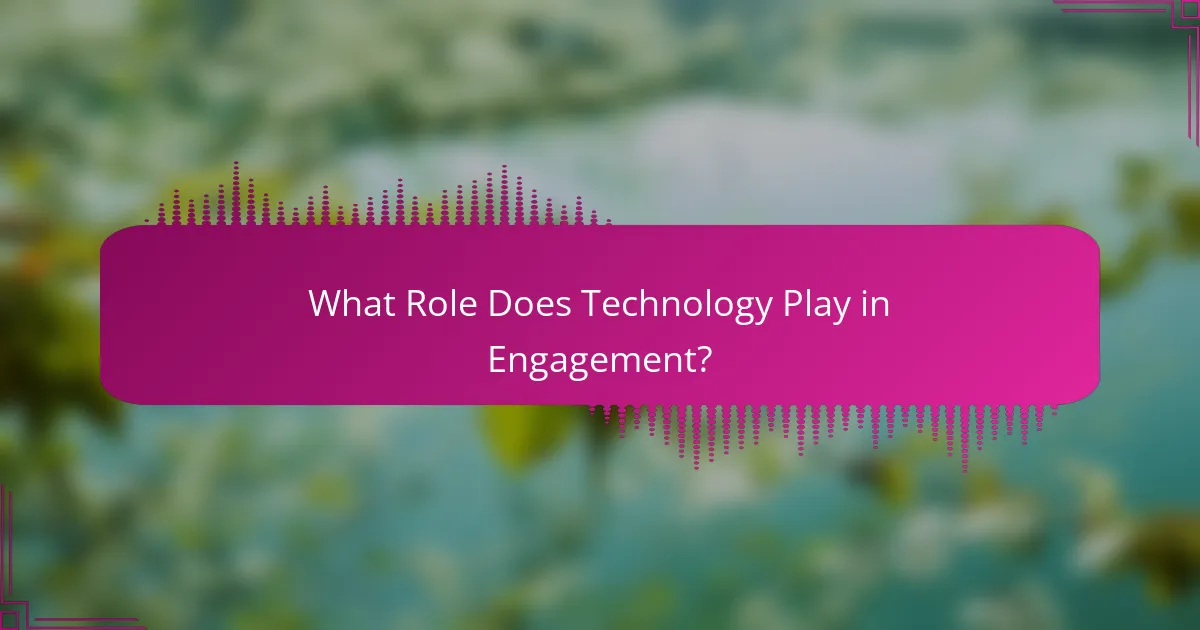Engaging viewers at festivals is essential for creating memorable experiences that resonate with attendees. By incorporating interactive activities and leveraging technology such as event apps and social media, organizers can foster meaningful connections and enhance audience participation. Measuring the effectiveness of these engagement strategies through feedback and interactions helps ensure that the festival meets the interests and expectations of its audience.

How to Engage Viewers at Festivals?
Engaging viewers at festivals requires a mix of interactive experiences and effective communication strategies. By incorporating activities that encourage participation, you can create memorable connections that enhance the overall festival experience.
Interactive Activities
Interactive activities are essential for engaging viewers at festivals. These can include workshops, hands-on demonstrations, or immersive art installations that invite participation. Consider activities that resonate with your audience’s interests to foster deeper connections.
For example, a music festival might offer instrument workshops or dance classes, while a food festival could feature cooking demonstrations. These experiences not only entertain but also encourage attendees to engage with the festival’s theme.
Live Polling
Live polling allows viewers to express their opinions in real-time, making them feel involved in the festival. Utilize mobile apps or social media platforms to conduct polls on various topics, such as favorite performances or food options. This instant feedback can enhance the experience for both organizers and attendees.
Ensure that polls are simple and quick to answer, ideally requiring just a tap or click. Display results live on screens to create excitement and encourage more participation.
Social Media Integration
Integrating social media into your festival strategy can significantly boost viewer engagement. Create unique hashtags for the event and encourage attendees to share their experiences online. This not only amplifies the festival’s reach but also fosters a sense of community among participants.
Consider setting up photo booths or designated areas for social media sharing, where attendees can capture and post their moments. Highlighting user-generated content on official festival channels can further motivate others to engage.
On-Site Contests
On-site contests are a fun way to engage viewers and create excitement at festivals. Organize competitions that align with the festival’s theme, such as costume contests, talent shows, or scavenger hunts. These activities can attract participation and create memorable moments.
Offer appealing prizes, such as festival merchandise or VIP experiences, to incentivize participation. Promote contests through announcements and social media to maximize visibility and involvement.
Networking Opportunities
Providing networking opportunities can enhance viewer engagement by fostering connections among attendees. Create designated areas for mingling or host panel discussions where participants can interact with industry professionals and fellow festival-goers.
Facilitate icebreaker activities or speed networking sessions to encourage conversations. This not only enriches the festival experience but also helps attendees build valuable relationships within their interests or industries.

What Tools Enhance Audience Engagement?
To enhance audience engagement at festivals, consider utilizing event apps, audience response systems, and social media platforms. These tools facilitate interaction, gather feedback, and create a more immersive experience for attendees.
Event Apps
Event apps serve as a central hub for festival information, schedules, and interactive features. They allow attendees to customize their experience by selecting sessions, creating personal agendas, and accessing real-time updates.
When choosing an event app, prioritize user-friendly interfaces and features like push notifications for important announcements. Examples include Whova and Attendify, which offer tools for networking and attendee engagement.
Audience Response Systems
Audience response systems enable real-time feedback and interaction during presentations or performances. Tools like Slido or Poll Everywhere allow participants to submit questions, vote in polls, or provide instant feedback through their smartphones.
Implementing these systems can increase participation and make sessions more dynamic. Ensure you test the technology beforehand to avoid technical issues during the event.
Social Media Platforms
Social media platforms are essential for engaging audiences before, during, and after festivals. They provide a space for attendees to share their experiences, connect with others, and access live updates through hashtags and event pages.
Utilize platforms like Instagram and Twitter to create buzz and encourage user-generated content. Consider running contests or challenges to motivate attendees to post and engage with your festival’s brand.

How to Measure Engagement Effectiveness?
Measuring engagement effectiveness involves assessing how well your audience connects with your content during festivals. Key metrics include direct feedback, social media interactions, and attendance figures, which collectively provide insights into audience interest and satisfaction.
Surveys and Feedback Forms
Surveys and feedback forms are essential tools for gauging audience engagement. Distributing these forms at the end of an event allows attendees to share their thoughts on various aspects, such as content quality, speaker effectiveness, and overall experience.
To maximize response rates, keep surveys concise and focused. Consider using a mix of multiple-choice questions and open-ended prompts to gather both quantitative and qualitative data. Offering incentives, like discounts for future events, can also encourage participation.
Social Media Metrics
Social media metrics provide real-time insights into audience engagement during festivals. Track likes, shares, comments, and mentions across platforms like Facebook, Instagram, and Twitter to understand how attendees interact with your content online.
Utilize social media analytics tools to monitor engagement rates and audience sentiment. Look for trends in posts that generate the most interaction, which can inform future content strategies. Engaging with your audience through comments and shares can further enhance their connection to your event.
Attendance Tracking
Attendance tracking is a straightforward yet effective way to measure engagement. Keeping records of ticket sales, check-ins, and session participation helps you understand which parts of your festival attracted the most interest.
Consider using digital ticketing systems that provide real-time data on attendance. Analyzing attendance patterns can reveal peak times and popular sessions, allowing you to tailor future events to better meet audience preferences. Additionally, tracking attendance can help in assessing the effectiveness of marketing efforts.

What Are Best Practices for Festival Engagement?
Best practices for festival engagement focus on creating meaningful connections with attendees through tailored experiences, ongoing communication, and inclusive activities. By prioritizing these elements, organizers can enhance attendee satisfaction and foster a sense of community.
Personalized Experiences
Personalized experiences at festivals can significantly enhance attendee engagement. This can be achieved through tailored content, such as customized schedules or interactive activities that cater to individual preferences. For instance, using attendee data to recommend specific workshops or performances can make the festival more relevant to each participant.
Consider implementing technology, like mobile apps, that allow attendees to create their own itineraries based on interests. This not only empowers attendees but also encourages them to explore various offerings throughout the event.
Consistent Communication
Consistent communication is vital for keeping attendees informed and engaged before, during, and after the festival. Utilize multiple channels such as social media, email newsletters, and event apps to share updates, reminders, and important information. Regular touchpoints help build excitement and ensure attendees feel connected to the festival.
Establish a clear communication schedule leading up to the event, and consider using countdowns or sneak peeks of performances to maintain interest. After the festival, follow up with surveys or thank-you messages to gather feedback and maintain the relationship.
Inclusive Activities
Incorporating inclusive activities is essential for ensuring that all attendees feel welcome and valued. This can include offering diverse programming that reflects different cultures, interests, and abilities. For example, providing workshops in multiple languages or accessible spaces can enhance participation from a broader audience.
Additionally, consider creating spaces for community interaction, such as open forums or collaborative art projects, where attendees can share their experiences and ideas. This fosters a sense of belonging and encourages attendees to engage more deeply with the festival and each other.

How to Create a Memorable Festival Experience?
Creating a memorable festival experience involves engaging attendees through thematic elements, unique performances, and immersive environments. These components work together to foster connections and enhance enjoyment for all participants.
Thematic Elements
Thematic elements set the tone and create a cohesive atmosphere at festivals. Consider aligning the festival’s theme with cultural or seasonal motifs, which can resonate with attendees and enhance their experience. For example, a summer festival might focus on beach vibes, while a winter event could embrace holiday traditions.
Incorporating visual and auditory elements that reflect the theme can further immerse attendees. This includes decorations, signage, and music that align with the chosen concept. Engaging local artists to contribute can also add authenticity and community spirit.
Unique Performances
Unique performances are crucial for capturing the audience’s attention and creating lasting memories. This could include a mix of local talent and renowned acts, ensuring a diverse lineup that appeals to various tastes. For instance, a festival might feature everything from live bands to dance troupes and spoken word artists.
Encouraging audience interaction during performances can enhance engagement. Consider incorporating elements like workshops or Q&A sessions with performers, allowing attendees to connect more personally with the artists and their craft.
Immersive Environments
Immersive environments transform festival spaces into engaging experiences. This can be achieved through creative staging, themed zones, and interactive installations that invite exploration. For example, a festival could create a “forest” area with natural decor and ambient sounds, drawing attendees into a different world.
Utilizing technology, such as augmented reality or interactive displays, can elevate the immersive experience. However, ensure that these elements are user-friendly and accessible to all attendees to avoid frustration and enhance enjoyment.

What Role Does Technology Play in Engagement?
Technology significantly enhances audience engagement at festivals by providing interactive experiences and real-time communication. It allows organizers to connect with attendees through various digital platforms, improving overall participation and satisfaction.
Interactive Experiences
Interactive technology, such as augmented reality (AR) and virtual reality (VR), creates immersive experiences that captivate festival-goers. For instance, AR can bring art installations to life, while VR can transport users to different environments, enhancing their festival experience.
Additionally, mobile apps can facilitate engagement by offering features like live polling, scavenger hunts, or gamification elements. These tools encourage attendees to participate actively rather than passively consume content.
Real-Time Communication
Real-time communication tools, such as social media and event-specific apps, allow organizers to share updates and engage with attendees instantly. For example, using platforms like Twitter or Instagram can help disseminate important information about schedule changes or emergency alerts.
Moreover, live streaming performances or workshops can extend the festival’s reach beyond physical attendees, allowing virtual participation. This hybrid approach can increase overall engagement and inclusivity.
Data Collection and Analysis
Technology enables the collection of valuable data on attendee preferences and behaviors, which can inform future events. By analyzing metrics such as attendance rates, social media interactions, and feedback surveys, organizers can tailor experiences to better meet audience needs.
Using tools like ticketing software and mobile apps can streamline data collection, making it easier to assess what worked well and what areas need improvement. This data-driven approach enhances the effectiveness of future festivals.
